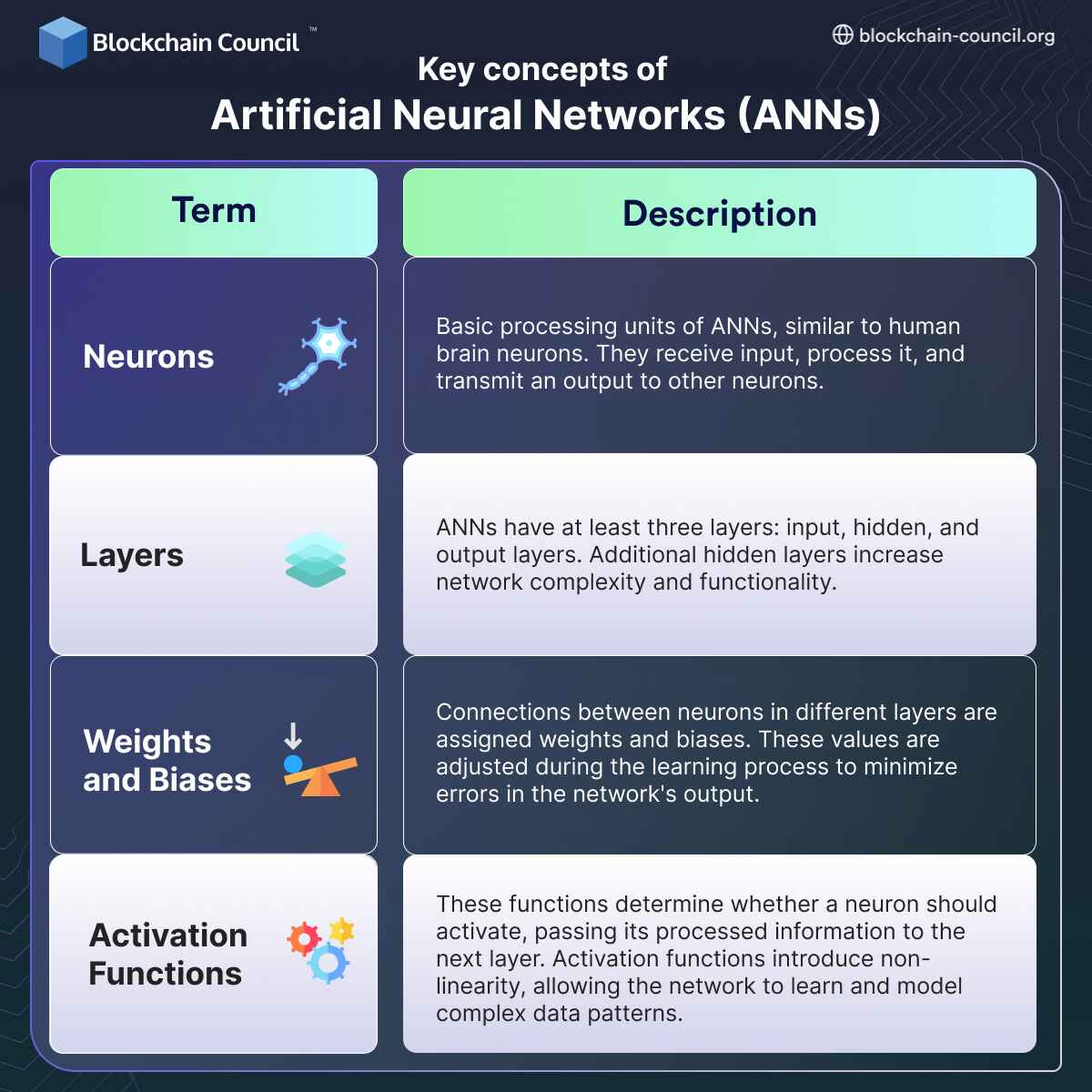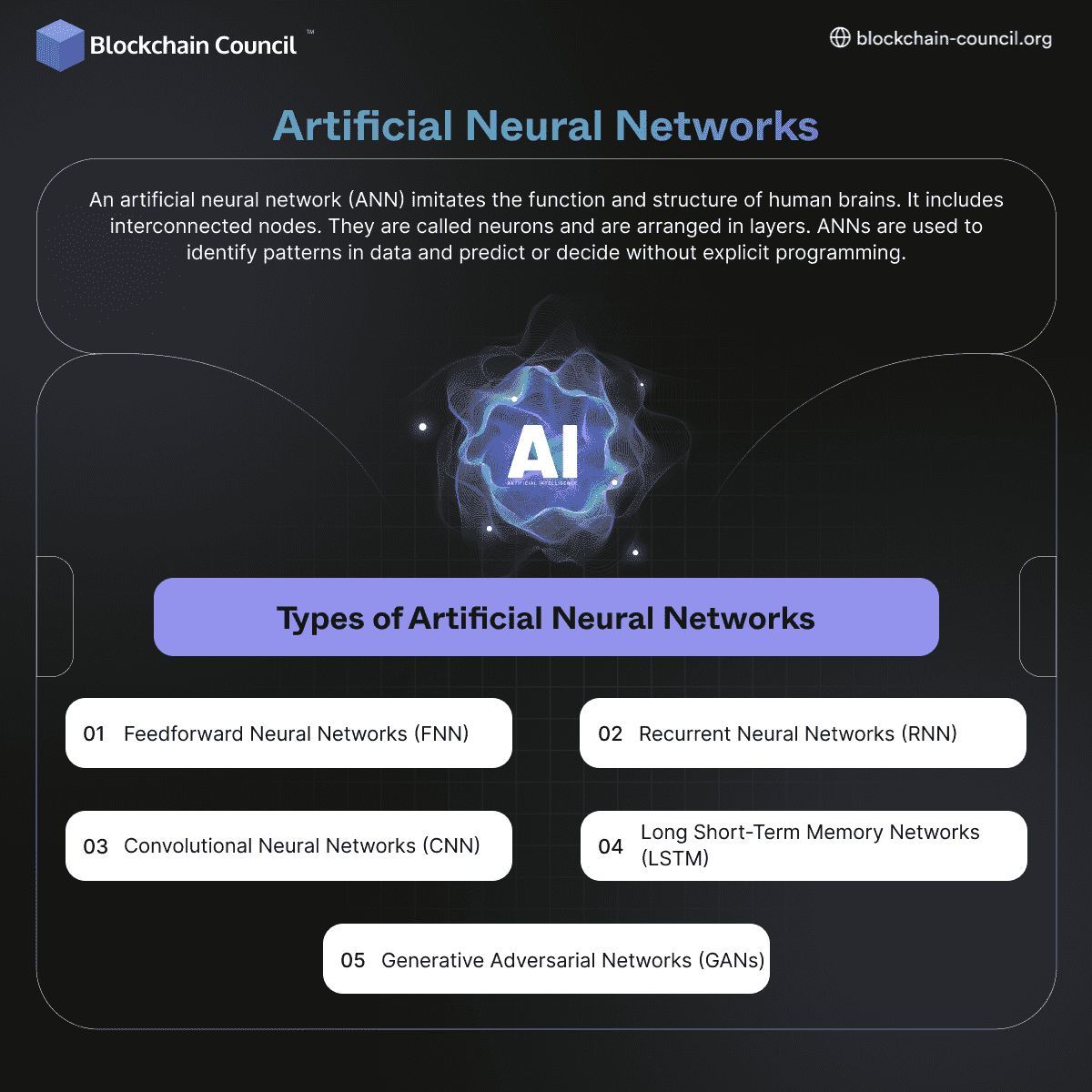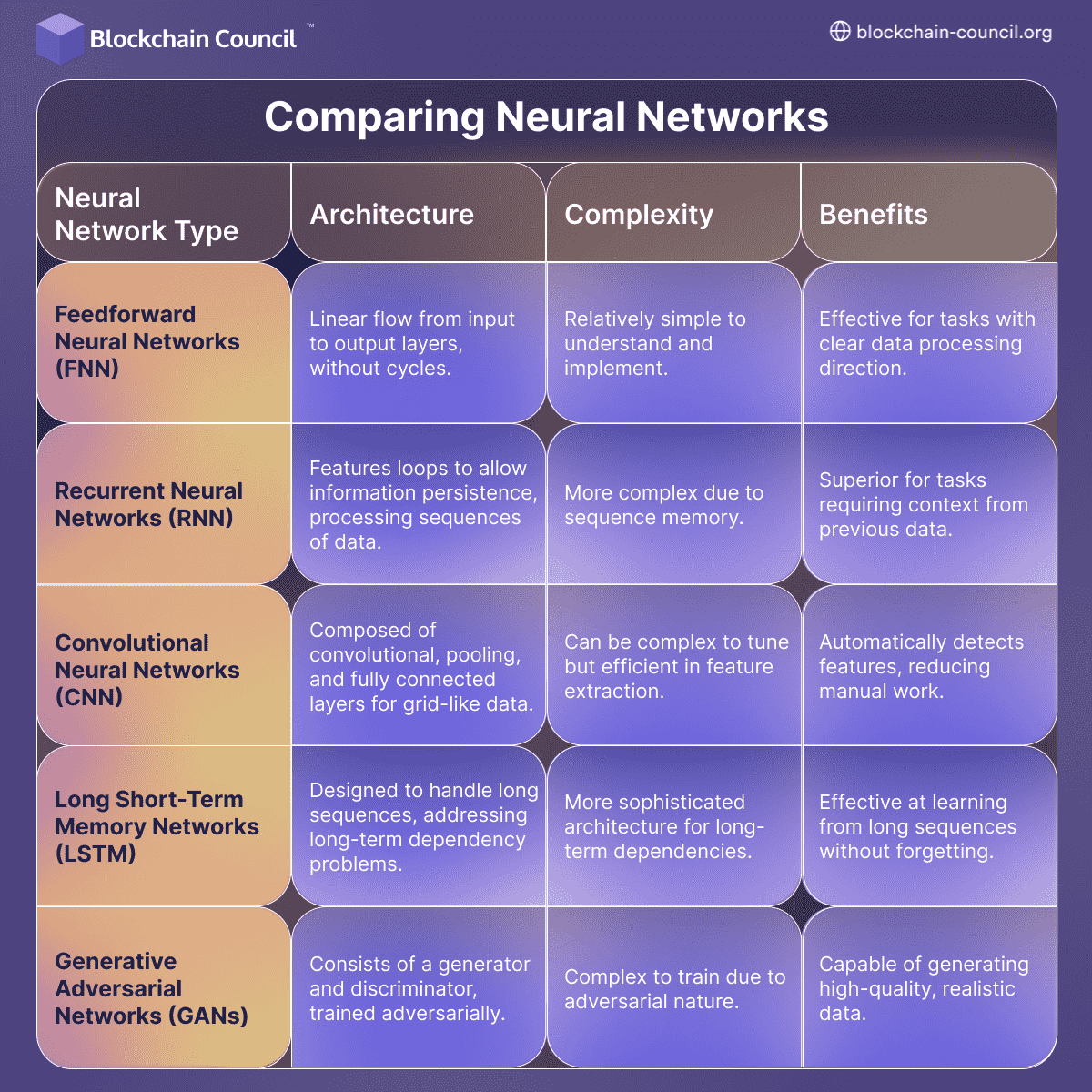
- Blockchain Council
- September 13, 2024
Introduction
Artificial Neural Networks (ANNs) are at the heart of artificial intelligence (AI), powering advancements that seemed like science fiction just a few decades ago. These computational models are inspired by the human brain’s structure and functionality, enabling machines to learn and make decisions with a degree of autonomy previously unattainable. This article aims to shed light on different types of Artificial Neural Networks (ANNs), detailing their uses and benefits across various fields. By comparing these networks, we will provide a comprehensive overview that showcases their significance in advancing AI technologies.
Basics of Artificial Neural Networks
The concept of neural networks is not entirely new; it draws inspiration from our understanding of the human brain. Just as the brain processes information through a complex network of neurons, ANNs use artificial neurons or nodes to process data. These networks consist of several layers: an initial layer for data input, one or more intermediate layers for data processing, and a final layer for producing the ultimate outcome.
Key Concepts of Artificial Neural Networks (ANNs)
The design of ANNs allows them to learn from data, identify patterns, and make predictions or decisions based on inputs. They are used in a wide range of applications, from image and speech recognition to predicting market trends and diagnosing medical conditions. By training a network with large datasets, it can improve its accuracy over time, making it an invaluable tool for solving problems that are too complex for traditional algorithms.
ANNs mimic the learning process of the human brain, albeit in a simplified manner, making them a cornerstone of AI research and development. Their ability to process vast amounts of data and learn from experience without being explicitly programmed for specific tasks gives them a versatile edge in tackling complex challenges across numerous domains.
Also Read: Deep Learning vs Machine Learning vs Artificial Intelligence: A Beginner’s Guide
Types of Artificial Neural Networks
Artificial Neural Networks (ANNs) have evolved into sophisticated models that can mimic the way the human brain processes information, enabling advancements in various fields such as image recognition, natural language processing, and more. Here’s an overview of some of the key types of Artificial Neural Networks (ANNs) and their applications:
Feedforward Neural Networks (FNN)
Feedforward Neural Networks are the simplest type of ANN architecture where connections between the units do not form a cycle. This structure consists of an input layer, one or more hidden layers, and an output layer. Information moves in only one direction—from input to output—making this network type straightforward to understand and implement. FNNs are commonly used in applications ranging from computer vision to facial recognition.
Recurrent Neural Networks (RNN)
Recurrent Neural Networks are designed to handle sequential data, such as time series or natural language. Unlike FNNs, RNNs have connections that form cycles, allowing information from previous steps to persist. This “memory” of past inputs enables RNNs to exhibit dynamic temporal behavior. They’re particularly effective for tasks like speech recognition, language modeling, and text-to-speech conversion.
Convolutional Neural Networks (CNN)
Convolutional Neural Networks are a class of deep neural networks, most commonly applied to analyzing visual imagery. They are structured with convolutional layers to identify patterns or features in images and pooling layers to reduce the dimensionality of the data. CNNs excel in tasks such as image and video recognition, image classification, and facial recognition. The architecture is inspired by the organization of the visual cortex and is particularly adept at processing data with a grid-like topology, such as images.
Long Short-Term Memory Networks (LSTM)
LSTM networks, a unique type of RNN, aim to overcome long-term dependency issues by retaining information for extended durations. LSTMs are composed of units called cells along with structures known as gates that control the flow of information. They are particularly useful for applications that require the model to make predictions based on long sequences of data, such as speech recognition, machine translation, and text generation.
Generative Adversarial Networks (GANs)
GANs consist of two networks: a generator that creates data and a discriminator that tries to distinguish between generated data and real data. This setup enables GANs to generate data that is similar to the input data. They are widely used for image generation, photo editing, and creating realistic computer-generated imagery (CGI) for movies and games.
Other Types of Artificial Neural Networks
- Autoencoders (AE): Utilized for learning efficient data codings in an unsupervised manner. They work by encoding input into a compressed representation and then decoding it back to match the original input.
- Variational Autoencoders (VAE) and Denoising Autoencoders (DAE): Variations of AEs for generating new data points and removing noise from data, respectively.
- Gated Recurrent Units (GRU): A variant of RNNs that simplifies the model architecture by combining several gates into one, making it more efficient yet delivering similar performance to LSTMs in many tasks.
Also Read: Top 10 Machine Learning Projects In 2024
Comparing Neural Networks
Artificial Neural Networks (ANNs) are powerful tools for solving complex problems across various domains. Each type of ANN has unique characteristics tailored to specific tasks. Below, we explore the key differences among several types of Artificial Neural Networks (ANNs) and offer insights on selecting the appropriate model for your application:
Choosing the Right ANN
The selection of an ANN depends on the specific requirements of your task:
- For tasks involving image or spatial data processing, CNNs are typically the best choice due to their efficiency in handling high-dimensional data.
- When dealing with sequence data or tasks that require remembering information from many steps back, RNNs or LSTMs are more suited.
- If the goal is to generate new data that mimics a particular distribution, GANs are likely the most suitable choice.
- FNNs serve well for straightforward predictive modeling where the data flow is unidirectional and does not involve complex patterns or sequences.
Remember, the complexity of training, the volume and type of your data, and the specific problem you aim to solve should guide your choice of neural network. It’s often beneficial to experiment with different architectures to find the one that best meets your needs, considering the trade-offs between training complexity, performance, and interpretability.
Benefits of Using Neural Networks
Artificial Neural Networks (ANNs) have sparked a revolution in how we approach problem-solving in many fields. They can learn and adapt by simulating the human brain’s neural connections, enabling them to handle highly complex tasks that traditional algorithms struggle with. Below, we explore the multifaceted benefits and some groundbreaking real-world applications of neural networks, showcasing their versatility and power:
Adaptive Learning and Self-Organization
Neural networks excel in modeling non-linear and complex relationships. They adapt and learn from previous knowledge, making them suitable for applications like predictive analytics, where they can forecast future events with remarkable accuracy. For example, they are used in predicting stock market trends, customer behavior, and even diagnosing diseases.
Real-Time Operation and Fault Tolerance
Their ability to operate in real-time and tolerate faults makes them indispensable in critical applications such as autonomous driving and space exploration. Neural networks can provide instant decisions and fill in missing information when parts of the network are lost.
Real-World Applications of Neural Networks
- Speech and Voice Recognition: Technologies like Siri and Alexa are powered by neural networks, enabling seamless interaction with devices through voice commands. This application extends to home automation, video games, and virtual assistants, making everyday tasks more convenient.
- Fraud Prevention in Finance: Neural networks analyze past account transactions to identify patterns indicative of fraudulent activity, enhancing security in financial operations.
- Enhancing eCommerce Experience: AI-driven recommendations on platforms like Amazon personalize user experience by suggesting products based on past behaviors and preferences, significantly boosting sales and customer satisfaction.
- Advancements in Cybersecurity: From protecting computers against viruses to exploiting vulnerabilities, neural networks are at the forefront of safeguarding digital assets and ensuring the integrity of data across networks.
- Medical Diagnostics: Convolutional Neural Networks (CNNs) have revolutionized medical imaging by enhancing the accuracy of diagnoses from X-rays, CT scans, and MRI images, aiding in the early detection of diseases.
- Autonomous Vehicles: Combining various neural network architectures, such as CNNs for image recognition and ANNs for decision-making, has made autonomous driving a reality, promising to transform transportation.
- Social Media Analytics: Neural networks analyze social media data to predict trends, user behavior, and personalize content, thereby shaping marketing strategies and enhancing user engagement.
- Aerospace and Defense: From autopilot systems in aircraft to strategy formulation in defense operations, neural networks ensure safety, efficiency, and strategic advantage in critical applications.
- Signature Verification and Handwriting Analysis: Banks and security systems rely on neural networks to authenticate signatures and analyze handwriting, providing a reliable method to prevent fraud and ensure authenticity.
Also Read: Top 10 Must-Have Machine Learning Skills
Challenges and Considerations in Neural Network Development
Developing neural networks involves overcoming significant challenges. One major issue is the complexity of designing these networks, which requires extensive data to learn effectively. Deep Learning (DL), a subset of Machine Learning (ML), operates without human-designed rules, relying on vast amounts of data to make connections between inputs and labels. This process is automatic, unlike traditional ML techniques that need manual feature selection, which can lead to biased outcomes if not done correctly.
Another challenge is understanding protein dynamics in biosciences. Although tools like AlphaFold2 have made groundbreaking predictions in protein structures, they mainly predict static structures. The dynamic nature of proteins and their interactions in biological processes pose ongoing challenges, indicating the need for further research in applying DL to understand and predict these complex behaviors.
Future Trends in Neural Networks
- The future of neural networks looks promising, with ongoing advancements expected in multiple fields. Deep Learning has already exceeded human performance in tasks like image classification, and its application is expanding into areas such as natural disaster estimation, drug discovery, and cancer diagnosis. The potential for DL to improve human lives is immense, providing more accuracy in medical diagnoses and fostering innovations in healthcare.
- In the realm of biosciences, DL’s application to protein function prediction represents a significant step forward. Tools like DeepGOPlus have shown remarkable success in annotating functions of proteins with higher accuracy than previous methods. Unsupervised methods like Denoising Autoencoders (DAEs) are also making strides in generating dense, robust representations of proteins, helping to assign missing Gene Ontology annotations more effectively.
- The development and application of neural networks are evolving rapidly, driven by the increasing computational power and the vast amounts of data available. As these technologies continue to mature, we can expect them to solve some of the most complex and pressing problems in science and industry, improving efficiencies, enhancing decision-making processes, and opening up new possibilities for innovation and discovery.
Conclusion
In summary, artificial neural networks (ANNs) have transformed the domain of machine learning and artificial intelligence. They exist in diverse forms, each offering distinct advantages and applications. Recognizing these distinctions is vital for making informed choices in your AI journey.
Ranging from basic Feedforward Neural Networks to intricate Recurrent and Convolutional Neural Networks, each kind possesses distinct strengths and ideal use cases. Whether it’s recognizing patterns in vast datasets, making predictions, or processing sequential and image data, ANNs are reshaping industries and enhancing technological advancements.
The exploration of ANNs reveals their critical role in driving innovation, solving complex problems, and opening new frontiers in research and development across various fields. Remember that the choice of an ANN type depends on the specific problem you’re trying to solve. Always consider factors like the nature of your data, computational resources, and desired accuracy when selecting the appropriate neural network architecture.
As we continue to push the boundaries of what’s possible with ANNs, their evolution will undoubtedly lead to even more sophisticated and capable AI systems in the future.
Frequently Asked Questions
What is the basic principle behind Artificial Neural Networks?
- ANNs are inspired by the human brain’s structure and functionality, using a network of artificial neurons or nodes to process and learn from data.
- They adapt and improve over time by adjusting connections based on input data, mimicking the learning process.
How do different Types of Artificial Neural Networks compare?
- Feedforward Neural Networks (FNNs) are the simplest type, ideal for straightforward prediction and classification tasks.
- Recurrent Neural Networks (RNNs) excel in processing sequential data, making them perfect for language modeling and time series analysis.
- Convolutional Neural Networks (CNNs) are specialized for image and video recognition tasks due to their ability to recognize patterns in spatial data.
- Long Short-Term Memory Networks (LSTMs) address the long-term dependency problem and are used in tasks like speech recognition and text generation.
- Generative Adversarial Networks (GANs) excel with visual data but have also been adapted for text, music, and other domains.
What are some real-world applications of ANNs?
- ANNs are used in a wide range of applications, including but not limited to, speech and image recognition, medical diagnosis, financial forecasting, autonomous vehicles, and personalized recommendations in e-commerce.
What challenges are associated with developing and using ANNs?
- Key challenges include the need for large datasets for training, the computational complexity and resources required, understanding and interpreting how the network makes decisions (the “black box” problem), and ensuring the network’s generalization capability without overfitting.








































































 Guides
Guides News
News Blockchain
Blockchain Cryptocurrency
& Digital Assets
Cryptocurrency
& Digital Assets Web3
Web3 Metaverse & NFTs
Metaverse & NFTs
